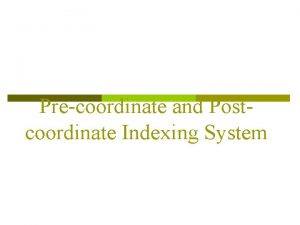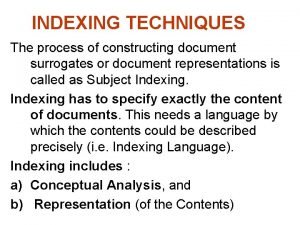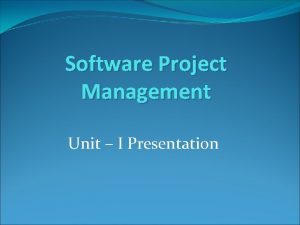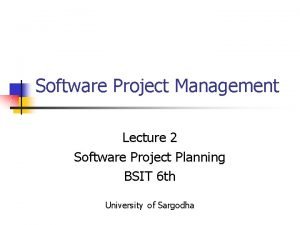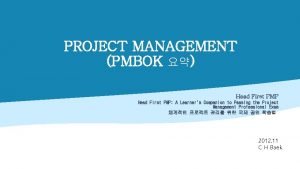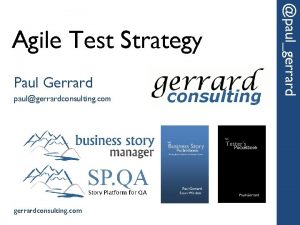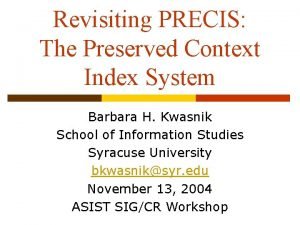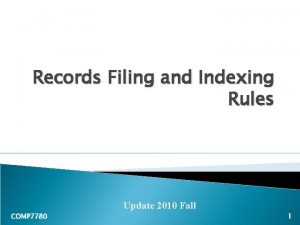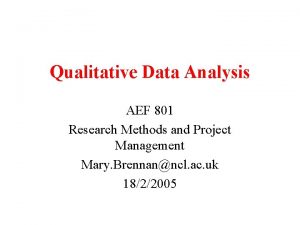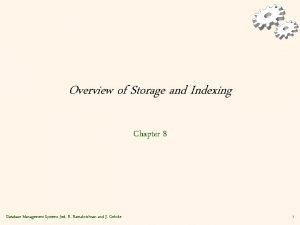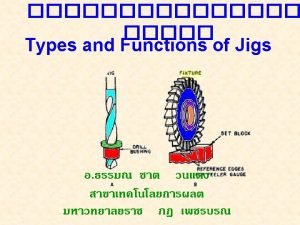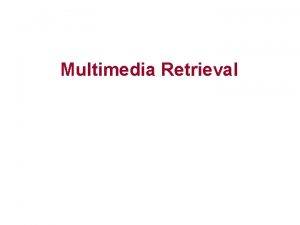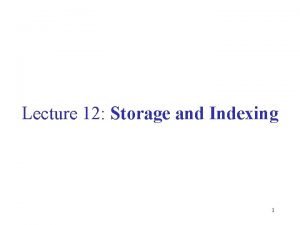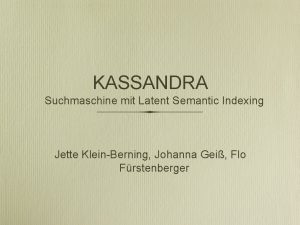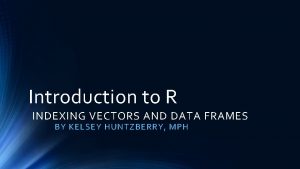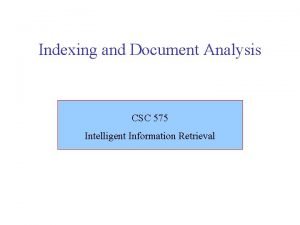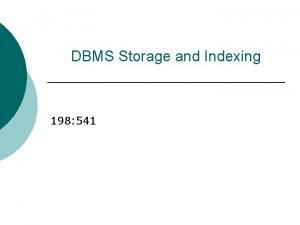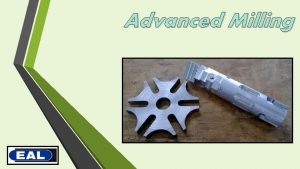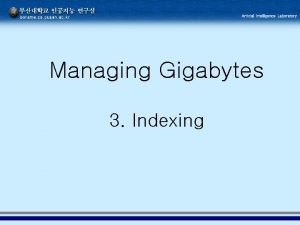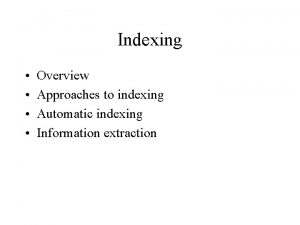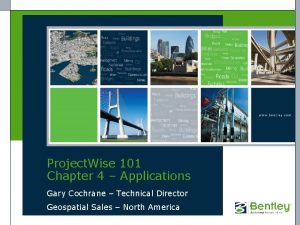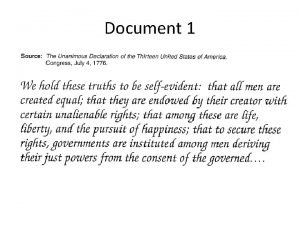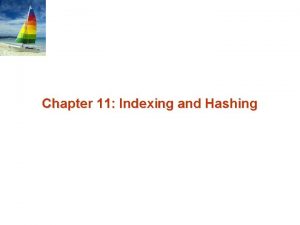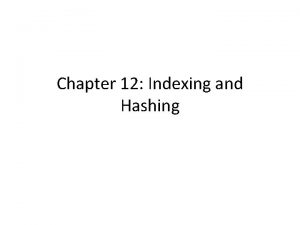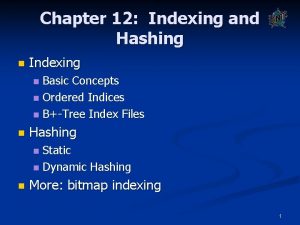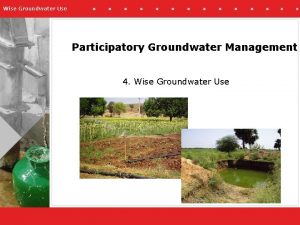Project Wise 101 Chapter 9 Document Indexing Gary






































- Slides: 38

Project. Wise 101 – Chapter 9 Document Indexing Gary Cochrane – Technical Director Geospatial Sales – North America

Introduction • Project. Wise Document Indexing – Really means three things • Full Text Indexing, in support of full text searching • Thumbnail Extraction • Document Property Extraction – We won’t cover this one in PW 101 – See Bentley Institute PW Admin course guide for this

Full Text Indexing • We did not write the engine for this – But elected to use the one Microsoft provides • Included with every copy of Windows – That engine is called the MS Indexing Service • And it was installed in the VM as an optional Windows component – Microsoft indexes the following file formats • MSWord, Excel, PPT, HTML, XML, TXT

Pre-installed in VM Project. Wise Integration Server Project. Wise Orchestration Framework Micro. Station V 8 i-SS 1 Supported Database Engine Microsoft Message Queuing Service Microsoft Indexing Service Microsoft. NET Framework 2. 0 Windows Server 2003 with SP 2

Extending the MS Index Service • Microsoft provides an SDK for third parties to extend the Indexing service – So the Indexing service will know how to “filter” files from that vendor • For instance, Adobe provides an “i. Filter” that teaches the MS Index Service how to extract text from a PDF file • The Adobe PDF i. Filter is installed with Acrobat Reader V 9 x

Indexing Overview • Within PW, Indexing consists of: – Scheduling • A process that wakes up, checks for new, (or modified files), adds them to the Copy-out queue, and goes back to sleep – Copy-out • Copy the file from the Storage Area, to the machine running the Indexing Service. Then add file to the extraction queue. • Remember, files may be stored on multiple servers • Also, in large installations, a machine may be dedicated to indexing

Indexing Overview – Part II • Overview – continued – Extraction • This process gets the text from the file and adds it to the MS Index catalog. Then adds the file to the Update queue – Update • This process sets the flag on the file (in the PW database) that says it is “done” • New files are added with the flag set to “undone” • Check-out/in causes the flag to be set to “undone”

A note on “done” • Done does not necessarily mean it was successful – It means the file has been processed • In other words, what happens if an unknown file (Ex: an Autocad file) is sent to the Indexing Service? – The file is attempted… • And the indexing service says, “I don’t know how to extract text from this file” – There would be no point in trying the file again • So it is marked as “done”, even when unsuccessful

Micro. Station and Auto. CAD • Project. Wise provides a mechanism to index the text from these file types – Instead of writing an i. Filter, Bentley elected to: • Copy-out the file • Run Micro. Station in the background, extract all the text, and write it to an XML file • Send the XML file to the Indexing Engine – Since Micro. Station can parse DWG as well… • Then this method saved us from having to write two i. Filters

Summary • So within Project. Wise, we index: – Word, PPT, Excel, XML, HTML, TXT – Adobe PDF – DGN, & DWG • More good news – i. Filters can be found for many file formats • Some free, and some for purchase

PW Orchestration Framework • Remember when we installed this? – PWOF is responsible for managing batch processes for Project. Wise • This includes all those processes discussed on the previous slides – For Full Text Indexing, that means • Scheduler process, Copy-out process, Extraction process, Updater process, and the Micro. Station instance running in the background

Lab 1 a • PW Orchestration Framework – Start the Windows Task Manager • Hint: Right-click on empty part of Taskbar – Examine memory usage • On the Performance tab – Switch to Processes tab • Sort by Mem Usage column (descending) • Look for ustation. exe • Look for Dms. Afp. Engine(s) – Lots of memory consumed here…

Lab 1 b • Now open Services dialog – Remember “gears” icon on Quick-Launch • Locate PW Orchestration Framework service – Select the PW OF service, and choose> Stop • Watch memory usage in Task Manager – For remainder of exercise, we need PWOF running • So start it back up now • Note PWOF is configured for automatic startup – It will run each time machine is booted – Close Services and Task Manager

Lab 2 a • Open PW Administrator – Log in as> adminpw – Drill down to: • Document Processors> Full Text Indexing – Right-click, choose> Properties

Lab 2 b - Full Text Indexing Accept defaut, unless Indexing is to be run on another machine Turn on adminpw Set to 60

Lab 2 c - Full Text Indexing Enable all times in the schedule Set to 2

Lab 2 d • Switch to File Type Associations tab – Press> Add • In the Extension field, enter> DWG • In the bottom field, enter> DGN – So that DWG files are processed as if they were DGN – Press> OK

Lab 2 e

Lab 2 f • Still on the File Type Associations tab – Again, press> Add • In the Extension field, enter> itiff • In the bottom, enable> Do not process these documents – You can’t extract text from a raster so this prevents wasted file transfers – Press> OK • Press OK again – To close the Full Text Indexing Properties

Lab 2 g • Open Task Manager again – Switch to Performance tab • Within 2 minutes, you should see heavy CPU usage • Memory usage will also go up – Up to 60 documents will be indexed in the first pass • If there are more than 60 documents to be done, then they will be queued in the next pass – 2 minutes from now

Analysis • All documents will eventually be processed – When done, the index will be ready for fast full text searches • Once the indexer has caught up, future load will be lighter due to only processing incremental documents

Lab 3 a • When done, close Task Manager, open PW Explorer – Log in as user 1 • From the main tool box, select> Find Documents – Binocular icon • Change to Full Text tab – Enter Look For> detail • Press OK to start search – Then Close the Search dialog • Your results should include: DGN’s, DWG’s, and PDF’s

Lab 3 b • Browse to: – User 1/Document Indexing/MS-SHT • These files were not successful because they have an unknown extension • But they were attempted, and flagged as done • Return to PW Administrator – Select datasource name (pwdemo) • • Right-click, choose> Properties Change to Statistics tab Choose Refresh Review Full Text Statistics – Close dialog

Lab 3 c • While still in PW Administrator – Open Full Text Indexing Properties again • Switch to the File Type Associations tab – Press Add • In the Extension field, enter> SHT • In the bottom Extension field, enter> DGN – So that SHT files will be processed as if they were DGN files • Press OK to complete the Extension mapping – Press OK again to close the Properties dialog

Lab 3 d • Once new file type has been added… – Now a small problem • These files were flagged as done, and the Indexer won’t try them again unless they are checked out/in • And even that won’t work unless you actually makes changes… • PW compares files to version on server, and doesn’t transfer back if there are no changes

Lab 3 e • Rather than check them all out, and back in – From PW Administrator • Right-click Full Text Indexing – Choose> • Mark folder Documents for Reprocessing – Browse “…” to • USer 1/Document Indexing/MS-SHT – Press OK • Press OK again

Analysis • Within 2 minutes, these documents will be reprocessed – If you run the search again (in a few minutes), you should also get SHT files in your results – Re-visit Datasource statistics to see if it Full Text categories have changed

Summary • Once the index is created, – You can stop the PW Orchestration Framework service • It is used to create the index, but not to search the index – This will save memory, and CPU cycles • So in a demo, your machine will run faster • BUT, new, (or modified) files will not be re-indexed – Up until now, the PWOF was not being used at all • Full Text Indexing is the first time we’ve needed PWOF, even though it has been running since installation

PW Thumbnails • PW Thumbnails is not “indexing” in the proper sense, but it is similar in nature to Full Text – PW Thumbnails extracts a thumbnail from the document, and stores a copy in the PW database • This allows one to browse PW Explorer, and see thumbnails in the Preview Pane – Not all file types support thumbnails • Among those that do, some don’t do it per the industry standard

Thumbnails – Part II • Important to remember – Project. Wise does not create thumbnails • It only extracts what might be in the file – A good test is to check to see if Windows Explorer displays a thumbnail for the file • If it does, then PW should as well

Lab 4 a • Open Windows Explorer – Browse to: • C: PW-101 Class FilesDocument IndexingMS-V 8 – Change to Thumbnail display • Micro. Station V 8 files have thumbnails

Lab 4 b • Browse through remaining Document Indexing folders – Note which include thumbnails – Additional notes • PDF files take a long time because you are really looking at a small view of the whole file, not a thumbnail • Auto. CAD doesn’t adhere to the Industry standard – These files only display correctly because Micro. Station is installed, and is responsible for displaying a thumbnail – Autodesk may have fixed this in later versions?

Lab 5 a • Open PW Administrator – Log in as> adminpw – Drill down to: • Document Processors> Thumbnail Extraction – Right-click, choose> Properties • Similar to Full Text Indexing – But actually less involved

Lab 5 b Turn on adminpw Set to 60

Lab 5 c Enable all times in the schedule Set to 2

Lab 5 d • No changed required on the File Type Associations tab – Press OK to complete the configuration and close the dialog • Within a few minutes, thumbnails should show up in the preview pane

Analysis • Thumbnails are extracted and stored in the PW database – Because document storage may not be local • Thus “touching” the document to see thumbnail in real-time is not practical – Thumbnail notes • Requires less processing than full text – Micro. Station not running in this process – Requires PWOF to extract, but not to display

Review • Topics covered in this Chapter – – – Full text Indexing – Configuration Full Text Searches Project. Wise Orchestration Framework Thumbnail Extraction Microsoft Indexing Service • And i. Filters to extend default supported file types • (I have a free Visio, and MSG i. Filter from Microsoft)
 Pre coordinate indexing system
Pre coordinate indexing system Contoh pengindeksan manual
Contoh pengindeksan manual He who walks with the wise grows wise
He who walks with the wise grows wise Document surrogates
Document surrogates Document
Document Step wise project planning
Step wise project planning Activity planning software project management
Activity planning software project management Step wise project planning
Step wise project planning Chapter wise summary of wuthering heights
Chapter wise summary of wuthering heights Stone angel summary
Stone angel summary The stone angel summary
The stone angel summary The stone angel chapter 1 summary
The stone angel chapter 1 summary Kocharethi chapter wise summary
Kocharethi chapter wise summary Who is the hero of joseph andrews
Who is the hero of joseph andrews The reluctant fundamentalist chapter 10 summary
The reluctant fundamentalist chapter 10 summary The reluctant fundamentalist summary chapters
The reluctant fundamentalist summary chapters The reluctant fundamentalist chapter 1
The reluctant fundamentalist chapter 1 Project initiation document
Project initiation document Brain maricks test quadrants focus on
Brain maricks test quadrants focus on Project concept document
Project concept document Pmi project charter example
Pmi project charter example Indexing in milling machine head part calculation
Indexing in milling machine head part calculation Precis indexing system
Precis indexing system Cross referencing in filing example
Cross referencing in filing example Counterdiscipline
Counterdiscipline Tree based indexing in dbms
Tree based indexing in dbms Jigs and fixtures difference
Jigs and fixtures difference Image indexing
Image indexing Nmcn indexing
Nmcn indexing Tree based indexing in dbms
Tree based indexing in dbms Kwoc indexing
Kwoc indexing Latent semantic indexing
Latent semantic indexing R indexing
R indexing What is intelligent indexing
What is intelligent indexing Clustered b+ tree
Clustered b+ tree Indexing in data warehouse
Indexing in data warehouse Chain indexing in library science
Chain indexing in library science Arma indexing rules
Arma indexing rules Indexing calculation in milling
Indexing calculation in milling
